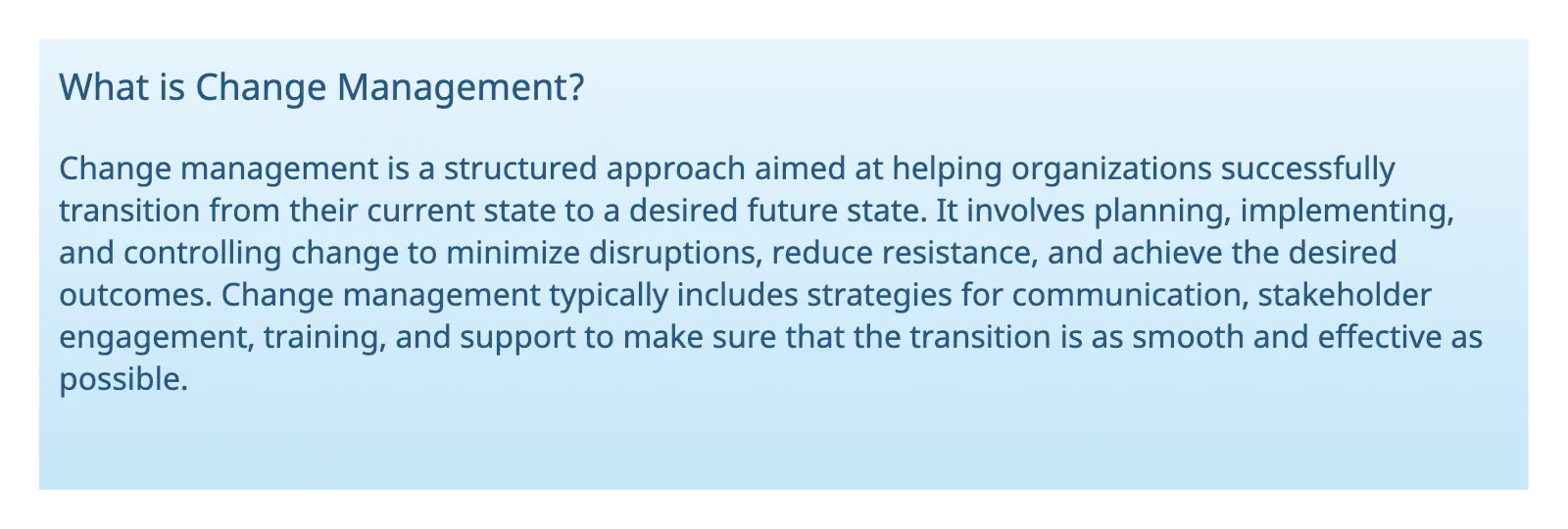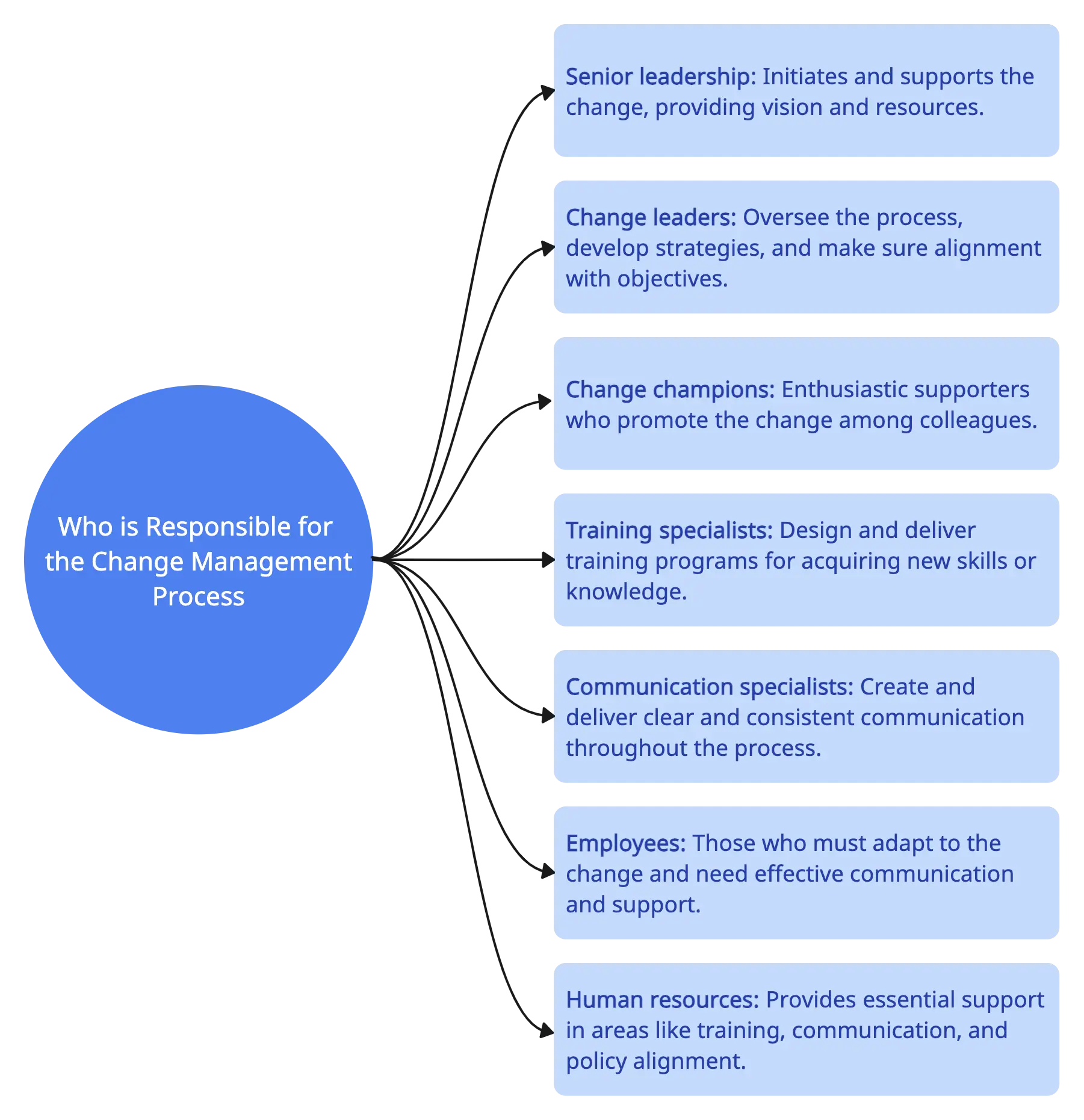

Change is a constant in the world of business and beyond. From adapting to new technologies to restructuring teams, understanding how to manage change is essential for success. This is where the change management process comes into play - it helps guide individuals and organizations through these changes, minimizing resistance, and achieving objectives efficiently. With this comprehensive guide to the change management process, you can learn how to navigate these transitions more effectively.

The change management process is a methodical approach for planning, implementing, and overseeing change within an organization. It is designed to help organizations and individuals manage transitions effectively.
It involves identifying the need for change, planning and analysis, stakeholder engagement, designing the change, implementing it, monitoring and evaluation, gathering feedback, and ultimately sustaining the change to become a part of the organization’s culture. This process helps organizations minimize disruption and resistance while optimizing the benefits of change.
Here’s a detailed breakdown of the change management process;

This is the starting point where you recognize that a change is necessary. It could be due to various reasons, such as market dynamics, new technologies, or internal issues. Identifying and understanding the reasons for change is crucial.
Once the need for change is identified, you create a comprehensive plan. This plan outlines the change’s objectives, scope, and potential impact on the organization. It should also include a timeline, resource allocation, and risk assessment.
Engaging with stakeholders is an important aspect of change management. This includes communicating with employees, customers, suppliers, and other relevant parties. It’s essential to gain their support and address any concerns they may have.
During this phase, you develop a clear vision of what the change will look like. This may involve defining new processes, technologies, organizational structures, or any other aspects of the change. The design phase sets the blueprint for the transition.
With a solid plan and design in place, you begin to put the change process into action. This often involves training employees, updating systems or processes, and making any necessary adjustments to align with the new vision.
Throughout the implementation, continuous monitoring and evaluation take place. You assess how well the change aligns with the initial objectives. This phase allows you to identify and address any issues or deviations from the plan.
Collecting feedback from stakeholders is a critical part of the process and can be done during a retrospective meeting. You should be open to feedback and use it to make necessary adjustments to improve the change process. Adaptation helps make sure that the change remains on the right track.
Once the change is implemented successfully, it’s essential to make sure that it becomes a permanent part of the organization’s culture. This involves creating new norms, behaviors, and practices that support the change and prevent a return to the old ways.
Change management process models are structured frameworks that offer a systematic and organized way to manage and implement change within an organization. They give a set of guidelines, steps, and best practices to help ensure that change initiatives are successful.
To learn more about these models in detail, refer to our post on change management tools.
In the change management process, several key stakeholders and roles play important parts in successfully planning and implementing change. These typically include:

Using an online visual collaboration platform like Creately can streamline communication, improve transparency, and boost teamwork throughout the change management process. It also helps make sure that all essential information is stored in a central location for easy access and reference.
Create a workspace dedicated to your change project in Creately. This workspace can be divided into different sections, each addressing various aspects of the change management process such as readiness for change, vision, objectives, stakeholder mapping, and communication planning. Invite all relevant stakeholders making sure everyone has access to it.
Facilitate collaborative brainstorming sessions where team members can contribute ideas for addressing challenges and seizing opportunities. Make use of premade brainstorming templates or sticky notes to visualize, record and organize ideas.
Store and manage all change management documents, templates, and resources within the same workspace. This includes change plans, communication materials, training resources, and risk assessment documents. You can add these as attachments inside the notes panel, links on shapes or as embeds in the workspace.
Use Kanban task boards and task cards to assign, track, and manage tasks related to the change process. Use these boards to assign ownership, set deadlines, and update task statuses.
Schedule and host virtual meetings and workshops using Creately’s integration with Microsoft TeamsCreately’s integration with Microsoft Teams. Create and share agendas, relevant documents, and visual aids using Creately.
Remember, change is not just a challenge; it’s an opportunity. By following the steps outlined in this guide and leveraging the capabilities of modern digital tools, organizations can use change as a driver for growth, fostering innovation, and a resilient culture.
Join over thousands of organizations that use Creately to brainstorm, plan, analyze, and execute their projects successfully.
Amanda Athuraliya is the communication specialist/content writer at Creately, online diagramming and collaboration tool. She is an avid reader, a budding writer and a passionate researcher who loves to write about all kinds of topics.